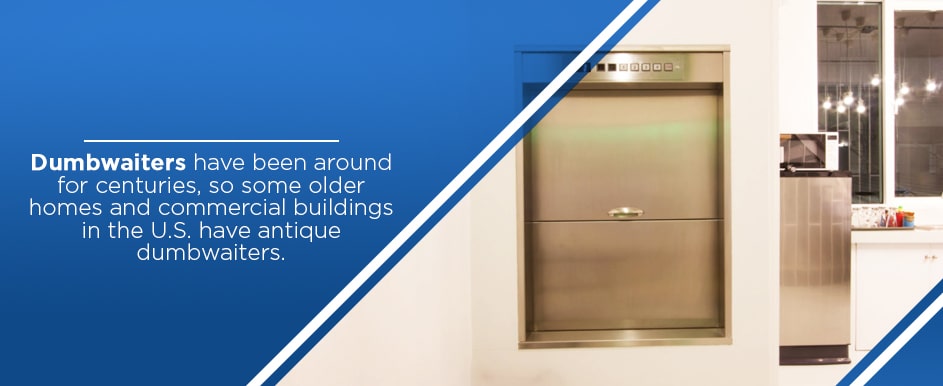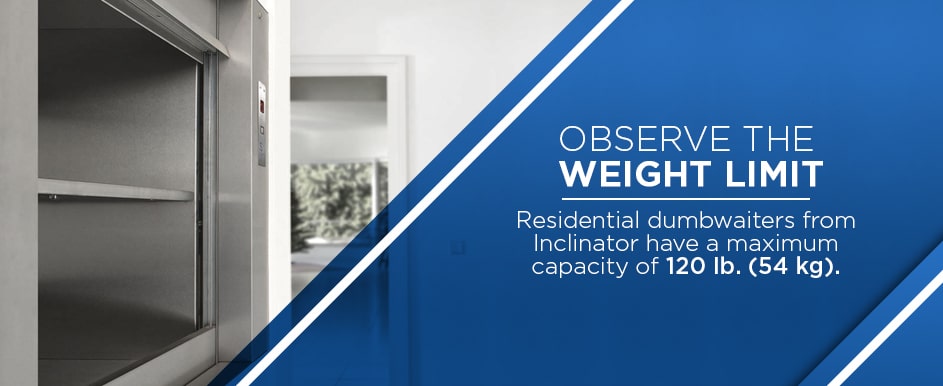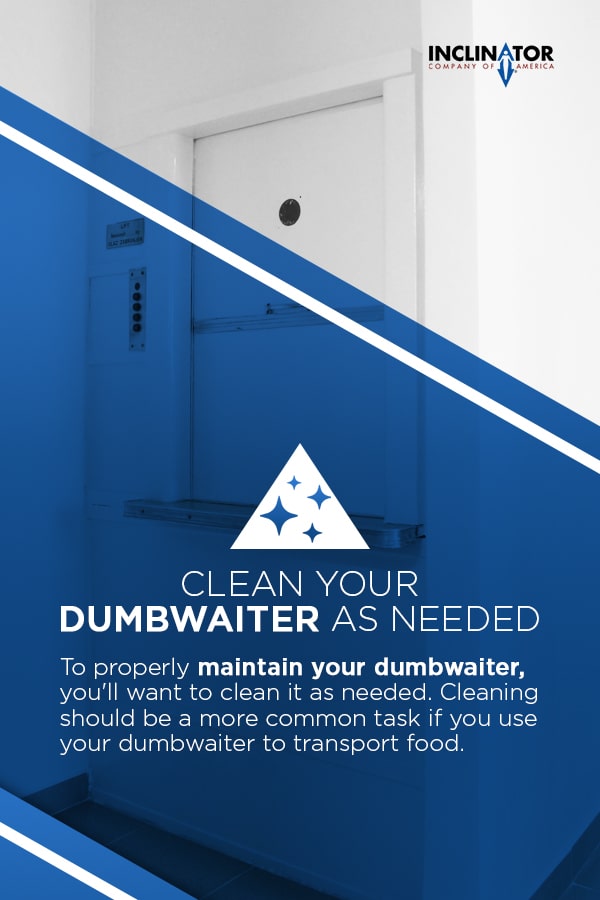Dumbwaiters are small elevators that are designed to transport items rather than people. Dumbwaiters have a valuable purpose, both commercially and residentially. They essentially function as a service elevator for items like laundry, tools, food and more. Residential dumbwaiters can be extremely helpful for people who would have trouble carrying items up and down stairs. A dumbwaiter can make a home a more accessible place. They are also extremely convenient, even if you don’t have any mobility limitations.
While dumbwaiters offer a lot of benefits, you may wonder whether these devices are safe. We are going to answer that question and look at 10 ways you can practice dumbwaiter safety and get the most out of your dumbwaiter.

Are Dumbwaiters Safe?
The answer to this question is yes, dumbwaiters are safe to use. Note, however, that older dumbwaiters found in historic homes, hotels and restaurants are more likely to be hazardous than modern dumbwaiters. If you have an old dumbwaiter you still use, you should have it inspected so you can determine whether you need to upgrade it to comply with current standards or potentially replace it entirely with a new system.
Dumbwaiters aren’t only safe to use — they can also make your home or workplace safer. This is because using a dumbwaiter to transport items can prevent hazards like falls on the stairs and overstrain.
Modern dumbwaiters have important safety features and reliable functionality that makes them safe for employees and homeowners to use. While dumbwaiters are safe overall, there are ways you can enhance the safety of your dumbwaiter and exercise caution at the appropriate times so that you have a positive experience using your dumbwaiter every time and enjoy it for years to come.
1. Installing a Dumbwaiter With Interlocks
Dumbwaiters have been around for centuries, so some older homes and commercial buildings in the U.S. have antique dumbwaiters. These dumbwaiters may still be functional in some cases, but they aren’t likely to be as safe as modern dumbwaiters. One safety feature, in particular, you should expect to see on a modern dumbwaiter is interlocks. Interlocks greatly enhance the safety of a dumbwaiter, which is why the American Society of Mechanical Engineers requires them.

The purpose of interlocks is to prevent you from opening up any access doors to the dumbwaiter while it is moving or stationed at a different landing. In other words, with interlocks in place, you can only access your dumbwaiter when it is safely stationed at the correct landing. This prevents the hazards that could occur if you opened your access door to an empty shaft or encountered a moving dumbwaiter. These hazards could be especially dangerous if you have small children in your home.
Modern interlocks are typically electromechanical. This means the dumbwaiter access doors remain locked by default but unlock when the dumbwaiter comes into contact with the access door, completing an electrical circuit. Make sure your dumbwaiter is equipped with interlocks so you can enjoy safe operation at all times.
2. Have Your Dumbwaiter Installed by a Certified Professional
If you’re planning on installing a dumbwaiter, make sure you have an experienced professional handle the installation. A certified professional, preferably one from your dumbwaiter’s manufacturer or distributor, will have the expertise needed to install your dumbwaiter correctly. They will also know how to maintain safety during the dumbwaiter installation process.
Some homeowners may feel they can take on a DIY installation project. While you may be able to figure out the process on your own, you’ll likely run into some challenges that could end up prompting you to call in the professionals anyway.
The only way to be sure your dumbwaiter is installed correctly is to leave the job to an experienced dumbwaiter installer. A poorly installed dumbwaiter can be unsafe and inefficient. Conversely, a dumbwaiter that has been accurately and securely installed is one you can count on to perform well and maintain a high level of safety.
3. Read Your Manual and Keep It On Hand
Your dumbwaiter should come with a manual that specifies its specifications and capabilities. Make sure you read the manual in its entirety so you understand the ins and outs of how to use your dumbwaiter properly.
Your manual may provide information on important aspects of your dumbwaiter, such as safety procedures, weight limits, maintenance tasks, and more. You want to make sure you follow all of these guidelines, even if they are posed as recommendations rather than requirements.
Note that, in some cases, you can void your warranty by ignoring instructions in the manual. Since you aren’t likely to memorize what you read in your manual, keep it handy so you can reference it whenever needed.
4. Observe the Weight Limit
One of the things your manual should note is the maximum weight capacity your dumbwaiter is designed to handle. This is one of the most important specifications to be aware of since exceeding the weight limit could damage your dumbwaiter. Residential dumbwaiters from Inclinator have a maximum capacity of 120 lb. (54 kg). Our commercial dumbwaiters have maximum capacities of 200 lb. (90 kg), 300 lb. (136 kg) or 500 lb. (226 kg).

Whatever the weight limit is on your dumbwaiter, be careful to stay under the limit so you don’t put unnecessary strain on your dumbwaiter. Especially when you’re first getting used to using your dumbwaiter, you should weigh items before placing them on the dumbwaiter so you can begin to develop a sense of how much your dumbwaiter can hold at once.
Aside from weight, you may be limited in the amount of space your dumbwaiter affords for items. Be careful not to cram too much in. Your dumbwaiter should be able to close easily and move from floor to floor with ease. Observing your dumbwaiter’s maximum capacity will help you avoid unnecessary repairs or replacements.
5. Allow Time Between Trips
Another way you can lessen the strain on your dumbwaiter and avoid any mechanical issues is by allowing the dumbwaiter to rest a bit in between trips. In other words, you’re typically better off spacing out your loads just a bit rather than constantly sending your dumbwaiter back and forth.
An overworked dumbwaiter could become overheated, leading to some problems or even total failure. Your dumbwaiter’s manual may speak to what level of use is normal and what would be considered overuse. When in doubt, just give your dumbwaiter a minute or two before sending another load.
Also note that this primarily applies to residential dumbwaiters, which are not as heavy-duty as commercial ones. A commercial dumbwaiter in a restaurant or hotel, for example, may be capable of handling frequent trips up and down to send many loads within a short period.
6. Keep Children From Playing With the Dumbwaiter
Whenever you’re considering the safety of something in your home, it’s important to think beyond the adults in the home. If there are any hazards present, they can tend to be a more significant issue for children. When it comes to dumbwaiters, features like interlocks should keep children safe. However, it’s still important that children use the dumbwaiter properly.
Depending on the size of your dumbwaiter, it may be large enough for a child to climb inside. Children are inquisitive and may see the dumbwaiter as an opportunity to take a fun ride. However, this is not a safe use of a dumbwaiter. Even if children are under the dumbwaiter’s maximum weight limit, that doesn’t mean the dumbwaiter is designed to carry them.
Make sure your children, grandchildren or any other kids who frequent your home know that the dumbwaiter is not a toy and is not the perfect child- or pet-sized elevator. If children want to operate the dumbwaiter, make sure they do so with adult supervision and guidance and only use the dumbwaiter for its intended purpose.
7. Do Not Use Your Dumbwaiter During a Power Outage
For automatic dumbwaiters that run on electric power, your dumbwaiter will not be functional during a power outage, unless you have backup generator power. If a power outage occurs while you are using your dumbwaiter, it will become stuck in place until your power comes back on. Therefore, you should refrain from using your dumbwaiter when you expect a power outage may occur, such as during a storm.
Sometimes, power outages are entirely unexpected, so you can’t always plan for these events. If you’re using your dumbwaiter and the power goes out, you should only experience an inconvenience, not a safety hazard. Still, it’s best to avoid using your dumbwaiter if you anticipate you may lose power in your home.
Note that home elevators—which are similar to dumbwaiters with the key difference that they are intended for transporting people—will not become stuck during a power outage. Home elevators from Inclinator have backup battery power that will kick in if the main power source goes out and will safely lower the elevator to the bottom level of the home.
8. Be Careful When Transporting Hot Items
If you use your dumbwaiter to transport items that are hot, such as food or dishes, make sure you exercise caution to maintain everyone’s safety. Especially in a commercial setting, when plates are coming out of a high-temperature dishwasher that heats the dishes to at least 180 degrees Fahrenheit, you must be extra careful to avoid being burned. Even when dishes are not piping hot, hot food and drinks can also cause burns if not handled with caution.
Make sure whoever is receiving the hot plates or hot food above or below you is aware that whatever arrives at their landing will be hot and should be handled carefully. Depending on how you pack items into the dumbwaiter, they could shift around during transport, so be sure to cover hot food so that it cannot slosh out.
Whenever opening a dumbwaiter containing hot items, be careful and wear heat-resistant gloves or some other form of protection for your hands when pulling out hot items. In commercial settings, you should already have precautionary procedures in place for handling hot items, but when using a dumbwaiter, the key is to communicate between floors so employees receiving hot items in the dumbwaiter know what to expect. An intercom system can be a great way to stay in communication.
9. Clean Your Dumbwaiter As Needed
To properly maintain your dumbwaiter, you’ll want to clean it as needed. Cleaning should be a more common task if you use your dumbwaiter to transport food. If something spills inside or leaves a residue, you’ll want to clean it up quickly so your dumbwaiter is ready for its next trip and won’t get any items dirty or cause them to slide around inside.

Don’t use just any cleaning product you have on hand to clean your dumbwaiter. Some cleaning products may be too harsh to use. Check your manual for approved cleaning agents. A safe option for any dumbwaiter is a damp cloth. Gently wipe out the dumbwaiter with the damp cloth and then wipe it dry or allow it to air dry.
You may also want to have your dumbwaiter professionally cleaned occasionally, especially if you regularly use it to transport food or other items that can leave behind a mess.
10. Have Your Dumbwaiter Inspected Annually
If you ever suspect your dumbwaiter is not functioning as it should, call a professional dumbwaiter repair service right away to inspect your dumbwaiter and diagnose the issue. One of the best ways to avoid issues in the first place is to practice proactive dumbwaiter maintenance. You can do this by scheduling annual inspections for your dumbwaiter.
A service professional will check to see if your dumbwaiter is in good working order and if it needs any repairs to continue functioning properly and safely. They may perform some maintenance tasks to keep your dumbwaiter in good shape, even if you’re not having any issues. For example, they may lubricate the cable system that moves the dumbwaiter.
Make sure you leave inspections to an experienced professional. While you may be able to look inside the car of your dumbwaiter, it is not safe for you to step inside the shaft to look for mechanical or electrical issues. To stay safe, let a professional handle this task. Talk to your installer about how to plan for annual inspections.
Dumbwaiters From Inclinator
If you want to install a dumbwaiter or have one serviced, you can depend on Inclinator. Our commercial dumbwaiters are designed to enhance your efficiency and safety at your restaurant, hotel, lab, medical facility, office building or any other commercial setting where you need to move items from floor to floor. Our residential dumbwaiters are perfect for seniors or people with physical disabilities who want to make their homes more convenient for them. Consider installing a home elevator from Inclinator as well to make your home a fully accessible place.
Our dumbwaiters and home elevators aren’t just practical — they are also customizable and elegant, so you can be sure your dumbwaiters will fit perfectly in your home. Find a dealer near you today to begin the process of planning your Inclinator dumbwaiter installation.
- 7 Signs You Need a Residential Elevator - December 7, 2023
- Home Investments That Help You Age in Place More Comfortably - October 12, 2023
- 3 Misconceptions About Home Elevators - December 9, 2021






